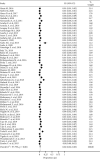Seroprevalence of Hepatitis C Viral Infection in Ethiopia: A Systematic Review and Meta-Analysis
- PMID: 33897305
- PMCID: PMC8052182
- DOI: 10.1155/2021/8873389
Seroprevalence of Hepatitis C Viral Infection in Ethiopia: A Systematic Review and Meta-Analysis
Abstract
Background: Hepatitis C virus is a highly genetically heterogenous bloodborne pathogen that is responsible for acute and chronic hepatitis. Globally, an estimated 71 million population is chronically infected with this virus from which 399,000 people die every year. Its prevalence is high in Ethiopia and varies from region to region, even among different studies within a region.
Methods: Electronic databases, including Science Direct, Medline, HINARI, African Journals Online, TRIP database, African Index Medicus, and Directory of Open Access Journals, searched from 2010 to 2020 and published articles were included. Due to evidence of considerable heterogeneity, the pooled prevalence of anti-HCV was analyzed using the random-effects model. The possible sources of heterogeneity were analyzed through subgroup analysis, sensitivity analysis, and meta-regression. Funnel plots and Egger's test statistics were used to determine the presence of publication bias.
Results: The analysis of 56 articles showed that the prevalence of anti-HCV in Ethiopia ranged from 0% to 22%. The pooled prevalence estimated was 2% (95% CI 2.0-3.0), and the meta-regression statistics indicated that the diagnostic method (p=0.037), study group (p=0.005), and level of bias (p=0.035) showed statistically significant association with the outcome variable. The sensitivity analysis claims no influence on the overall effect estimate while removing a single study from the analysis at a time. Egger's test statistics (p ≤ 0.001) declare the presence of publication bias that is handled using time and fill analysis.
Conclusions: The pooled prevalence of anti-HCV in Ethiopia was high. Predictor variables, including the diagnostic method, study group, and level of bias, showed a statistically significant relationship with the outcome variable. Strengthening the scope of existing prevention and control programs and implementing novel approaches, including screen-and-treat, could significantly help to tackle this critical public health issue. The study provides a current estimate which is valuable for policymakers and other responsible bodies.
Copyright © 2021 Teshiwal Deress et al.
Conflict of interest statement
The authors declare that they have no conflicts of interest.
Figures




References
-
- Alavian S. M., Hajarizadeh B., Ahmadzad-asl M., Kabir A., Bagheri- L. K. Hepatitis B Virus infection in Iran: a systematic review. Hepatitis Monthly. 2008;8:281–294.
-
- WHO hepatitis C key facts, https://www.who.int/news-room/fact-sheets/detail/hepatitis-c, 2019.
Publication types
MeSH terms
LinkOut - more resources
Full Text Sources
Other Literature Sources
Medical

